White’s first Japanese cruiser:
The Naniwa and Takachiho (浪速型防護巡洋艦 Naniwa-gata bōgojun’yōka) were the first Japanese protected cruisers. They were also considered at their completion, the most advanced and powerful cruisers in the world.

Since naval industry in Japan was in its infancy, there was no skills available to design, let alone to built a cruiser. Until the start of the century, Japanese authorities ordered many warships to the British and French, learning skills and transferring technology in the process. This was a bit like China in the 1980s. The Imperial Japanese Admiralty estimated this intermediary type of cruiser, the protected or “second class” cruiser was a more potent way to patrol trade routes and protect Japanese distant interests, with more firepower and speed than a gunboat.
Such ship can also perform scout missions for the fleet, or even replace a battleship for small navies. Such was the case with Japan, barely out the meiji era. Also major concerns over China through the Korean case drew attention of the recently updgraded Chinese Beiyang Fleet, on paper quite superior to the IJN.
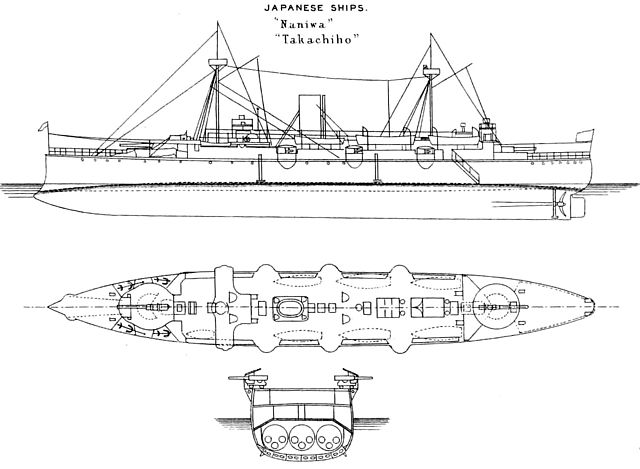
Brassey’s 1888 depiction of the class.
William White, the chief engineer and general manager of Armstrong Whitworth, at Elswick in UK, then a largest warship’s yard in the world, delivering ships for export in droves, created a ship tailored for foreign customers. A a fraction of a price of an ironclad, they could have a faster, well protected ship, armed with heavy artillery. This was a seductive package and White soon the company received orders, starting with Chile, in rivalry with Brazil and Argentina. White designed the Esmeralda and was asked soon after by the Japanese government to draw a derivated design for the IJN. The latter indeed sent falous naval architect Sasō Sachū, pioneering Japanese naval architect to Great Britain in order to aquire this Elswick design.
Both were ordered under the 1883 fiscal year budget, by Naval Minister Kawamura Sumiyoshi, for a global budget of cost £546,980. For the anecdote, the minister was given a toast during a dinner by with Baron William Armstrong, saying “the ship was destined to the service of a country which was likely never to come into collision with our own peace-loving country”.
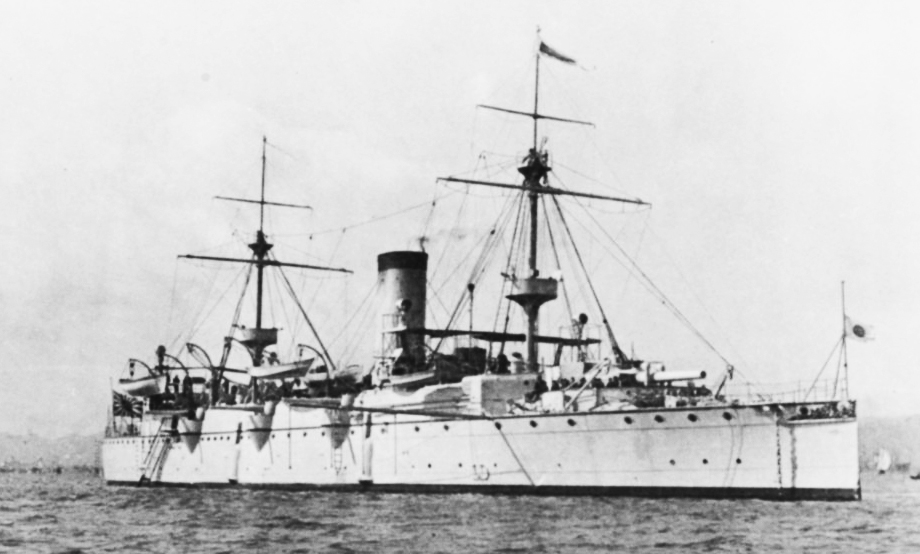
Cropped article photo – Naval History and Historical command src
Design
The revised design by Sasō Sachū produced a very powerful yet cost effective ship as stated, compared to pre-dreadnoughts. It was a perfect fit for a young and budget-restricted IJN. Saso Sachu when in Eslwick asked modifications compared to the Esmeralda, with changes in weaponry like Krupp guns, changed in armor thickness and raw machinery power, for a slightly better speed. Their hulls were typically flush deck, symetrical, and with the high freeboard required for seaworthiness in the Pacific.
The hull received a ram blended into the reinforced bow. Both main guns were in barbettes with a rather flimsy armored shield, intended to deal with shrapnells. The rest of the artillery was classic, in side sponsons, tailored for the usual line of battle tactic.
Propulsion
Two two-stage horizontal steam reciprocating engines (rated for 7000 hp) drove two shafts, propelling the ships up to 18 knots. This was not blazing fast but for the time, already at least three knots faster than any battleship.
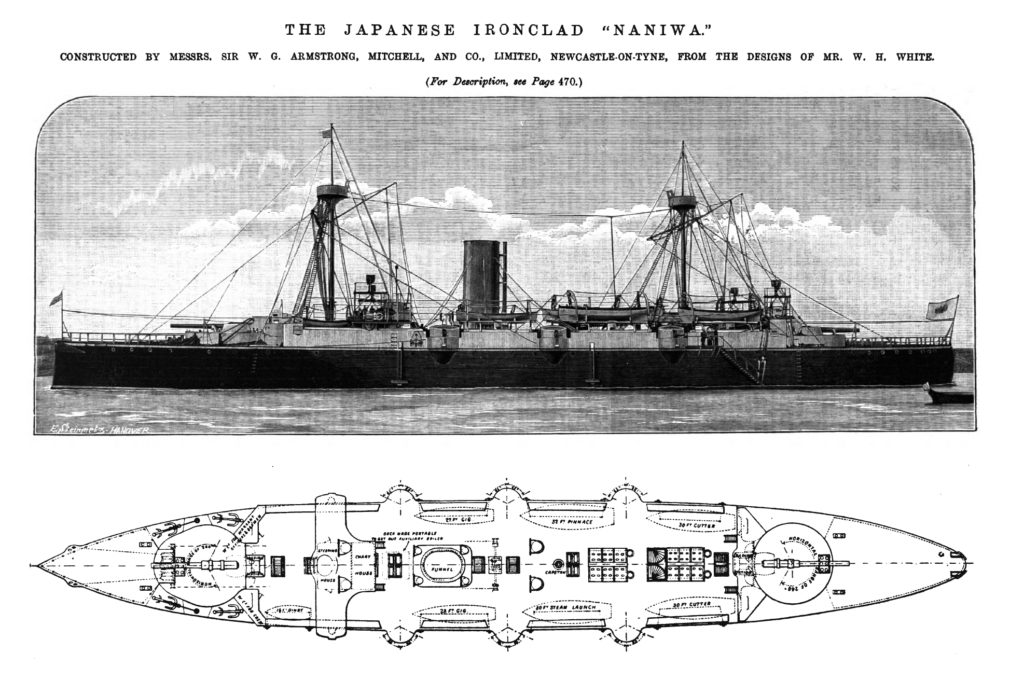
Press extract from Jane’s – Notice the ship is labelled an “ironclad”, which is telling volumes about its protection
Armament

Naniwa’s front gun and officers. Src
Both ships of the Naniwa class were armed with two 10 inches or 260 mm L/35 Krupp guns. This main battery was quite impressive for a cruiser of such displacement, but that was the same concept as the Esmeralda. By their range they could hit a battleship and escape through their speed, unharmed. However the rate of fire was absymal. It is difficult to find informations about this rather rare model, no longer used during WW1. The standard 280 cm was derived from it. 200 rounds were provided per gun, HE and AP.
Secondary armament
This comprised six 6-in or 152mm L/35 Krupp guns, or 15 cm Schnelladekanone Länge 35. They were quite a popular model, also exported to Austria-Hungary, China, Denmark, Japan, The Netherlands, The Ottoman Empire, Romania and Spain. It was soon adopted by early ironclads (modernized), protected cruisers, turret ships and coastal defense ships.
Her trump card was speed: It was designed around a 1.33 m (4 ft 4 in), 68 kgs single piece round for fast-firing. But due to the weight of the rounds, many navies asked the rounds to be split up down to a more classic and manageable two part quick loading cased charges. In fact, this way, the rate of fire was even better.
The paradox is that kind of gun was quite common among Chinese ships later encountered by the Japanese… After modification the rounds were 45.6 kg (101 lb), for 4-5 rpm. Muzzle velocity was 650 m/s (2,100 ft/s) while top firing range was 10 km (6.2 mi) at +19°.
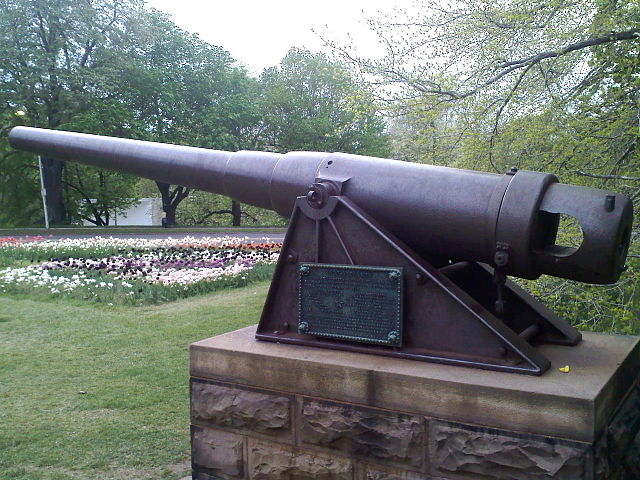
Preserved 15 cm Krupp L/35 guns from the Spanish cruiser Castilla.
In addition for anti-torpedo boat warfare, six QF 6 pounder Hotchkiss’s were placed ten 1-inch Nordenfelt guns and four 11 mm, 10-barrel Nordenfelt guns. For close quarters, four 356mm (14 inches) torpedo tubes were installed on the main deck in a cross pattern.
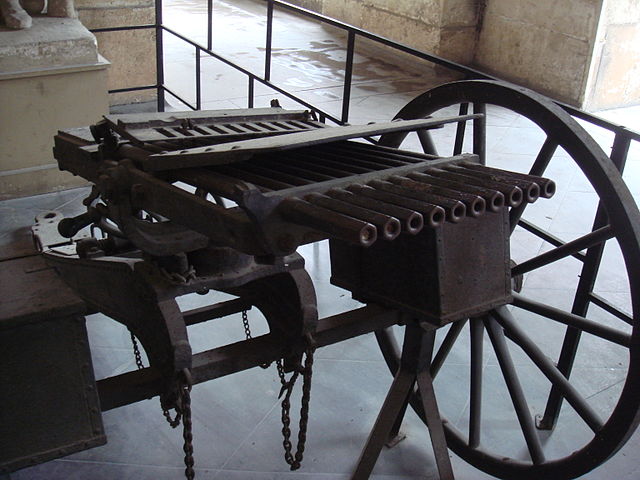
10-barrels Nordenfelt gun.
Protection
Compound armor is likely to have been used, (a mix of steal and teak), as Harvey armor appeared later in the 1890s as well as Krupp’s hardened face steel. The Naniwa class were protected by 50 to 75mm thick deck armor, with the secondary guns protected by 37mm shields. The conning tower has walls 150 mm thick (6 in). It was better than the Esmeralda, though way below the lever of protection of a battleship.
⚙ specifications as buit |
|
| Displacement | 3,727 long tons (3,787 t) |
| Dimensions | 320 x 46 x 20 ft 3 in (97.5 x 14 x 6.2) |
| Propulsion | 2 shafts CE steam engines, 6 cyl. boilers: 7,500 ihp (5,593 kW) |
| Speed | 18 knots (33 km/h; 21 mph) |
| Range | 9,000 nmi (17,000 km; 10,000 mi) at 13 knots (24 km/h; 15 mph) |
| Armament | 2× 260, 6× 150, 2× 57, 10× quad 25 mm guns, 4× 10-barrel 11 mm HMGs, 4× 356 mm TTs |
| Protection | Deck 2–3 in (51–76 mm), CT 3 in (76 mm) |
| Crew | 338 officers and sailors |
Career of the Naniwa & Takachiho
Both ships were active, but it was cut short before WW1. Anyway their superiority was short lived. In 1890 already due to the extremely fast development of technology, weaponry and armor their design supremacy did not last long. Naniwa was launched 18 March 1885, and completed 1 December 1885, same completion date as Takachiho.
The frst Sino-Japanese war broke out in 1894 and the Naniwa and Takachiho joined Admiral Itoh Sukeyuki’s “flying squadron”. Both fought at the Battle of Yalu River (or Yellow river), but only IJN Naniwa was present as the Battle of Wei-hai-wei, and later during the invasion of Taiwan. At Yalu, Naniwa help destroying the Jingyuan and Zhiyuan but she also took a 210 mm hit, fortunately with little damage.
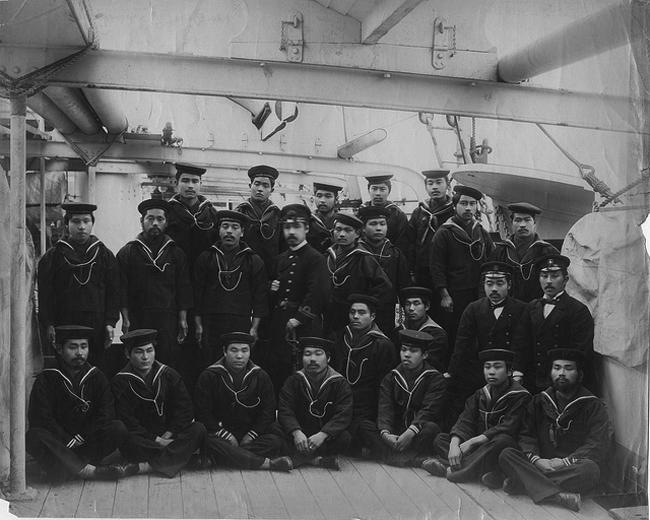
Photo of the Naniwa’s crew, taken at Newcastle
Naniwa also fought at the Battle of Pungdo 25 July 1894 off Asan in Korea, at the opening of the hostilities. She was part of the “flying squadron” with the cruisers Yoshino and Akitsushima, detached from the main fleet to join the cruiser Yaeyama and gunboat Oshima from Chemulpo, sailing to the island of Pungdo, to patrol the western coast and intercep possible reinforcements. However due to communication breakdown, the Yaeyama and Oshima remained at Chemulpo.
Nevertheless the cruiser Jiyuan and torpedo gunboat Kwang-yi in Asan sailed to join the transport Kowshing and gunboat Tsao-kiang from Tianjin. Near Pungdo they were spotted and fired upon by the flying squadron and the battle started. Both Chinese ships were badly hit, the Kwang-yi was sunk and the Jiyuan fled, with the flying squadron in hot pursuit. The sinking caused a diplomatic incident between Japan and Great Britain, later resolved by lawyers.
Naniwa was also part of the invasion of Taiwan, and shelled on 3 June and 13 October 1895 the Chinese coastal forts of Keelung and Takow under command of the future ww2 admiral admiral Kataoka Shichirō. At the time the USN attacked the Spanish fleet at Manila, the Naniwa has just been redesignated 2nd-class cruiser in March 1898. She was based in Taiwan, patrolling the area from the Philipines to Taipei.
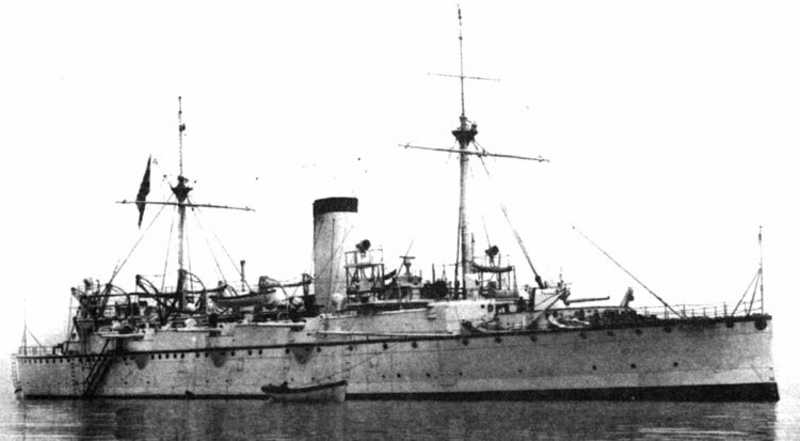
Naniwa in 1898, with an all-white livery.
Both sister-ships intervened during the “Black week”, when US marines and Europeans overthrown the Hawaiian monarchy. Japan and the United Kingdom on their side tried to help the provisional government, Naniwa’s marines being landed to protect Japanese citizens and assets in the Island. There were indeed a frenzy of anti-Japanese sentiment at that time. In 1900-1901 Naniwa’s main battery was removed, replaced by lighter Elswick QF 6 inch /40 naval guns. This bring her more stability and the same standard as the rest of the fleet.
At the start of the new century, this was the Boxer Rebellion, and IJN Takachiho was sent to China, supporting Japanese troops at Tianjin with a reinforcement of Marines.
When the Russo-Japanese war broke out, Naniwa took part in the Battle of Chemulpo Bay.
During the Russo-Japanese war, Naniwa was based at Tsushima and participated in the Battle of Chemulpo Bay. Asama, Naniwa, Takachiho, Chiyoda, Akashi and Niitaka attacked assisted by TBs advanced elements of the Russian fleet and badly damaged the Varyag, which was later captured and incorporated into the IJN. On 10 March 1904 with her sister-ship she participate in the blockade. At the Battle off Ulsan on 14 august 1905, Naniwa help sinking the armoured cruiser Rurik, and later recuing survivors.
At Tushima she was the flasghip of rear-admiral Uryū Sotokichi, part of the Fourth Division of the Combined Fleet. She was damaged but was repaired back in Japan and subsequentely patrolled the northern seas off Hokkaido. In 1912 she has been relegated as a survey ship, mapping the Kurile Islands’s coast. Without modern equipments, this was a dangerous task, and she ran aground coast of Urup, foundered and declared a constructive loss after all atempts to two her failed. She was stricken from the navy’s lists.
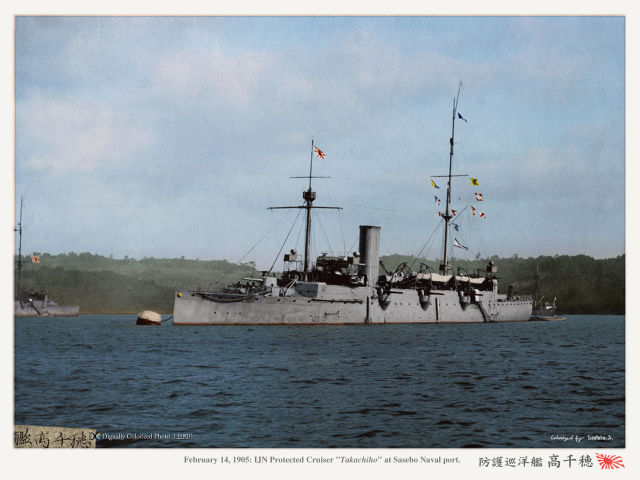
IJN Takachiho in February 1905 – Notice the grey livery
IJN Takachiho had about the same history, including the refitted with modern British guns in 1901, Boxer rebellion, and Russo-Japanese War, in the 2nd Fleet under the overall command of Vice Admiral Kamimura Hikonojō. On 28 August 1912 she was relegated as 2nd class Coastal defence ship and converted as a minelayer and mine recovery training vessel, one of her 152 mm gun removed to free space for mines. When the war broke out on 23 August 1914, Takachiho as sent at Tsingtao, the German naval base, to assist the siege. However by 17 October 1914 she was attacked by the German torpedo boat S90, 10 nautical miles southeast of Jiaozhou Bay, torpedoed and sank. She was one of the rare Japanese ships sunk by the German Navy…
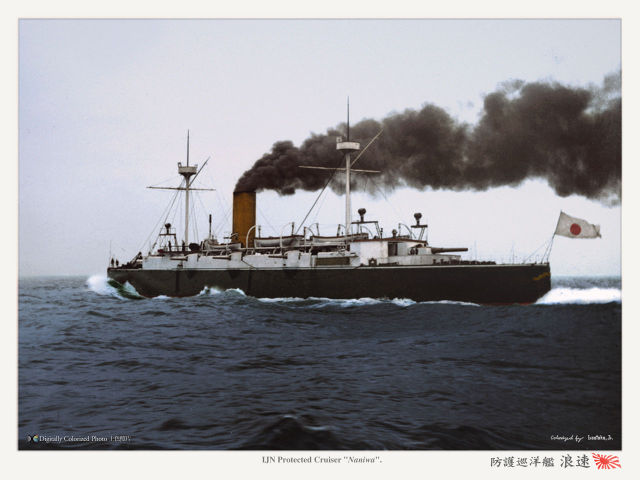
IJN Naniwa after completion, underway, perhaps during sea trials
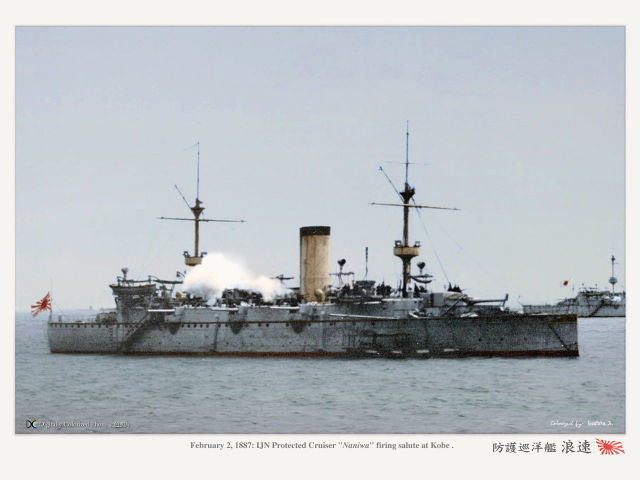
.
All three: Colorized photo by Hirootoko Jr.
Read More/Src
Conway’s All the World’s Fighting Ships, 1860–1905
Chinese Battleship vs Japanese Cruisers: Yalu River 1894, By Benjamin Lai.

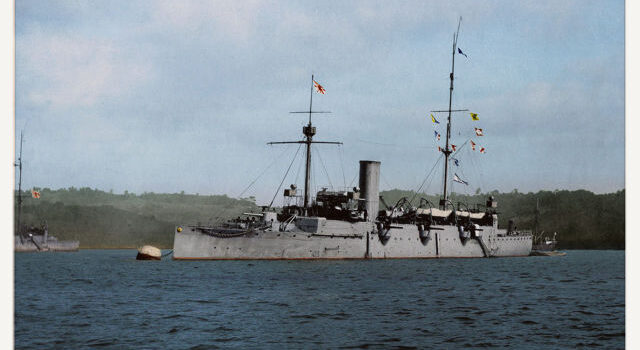

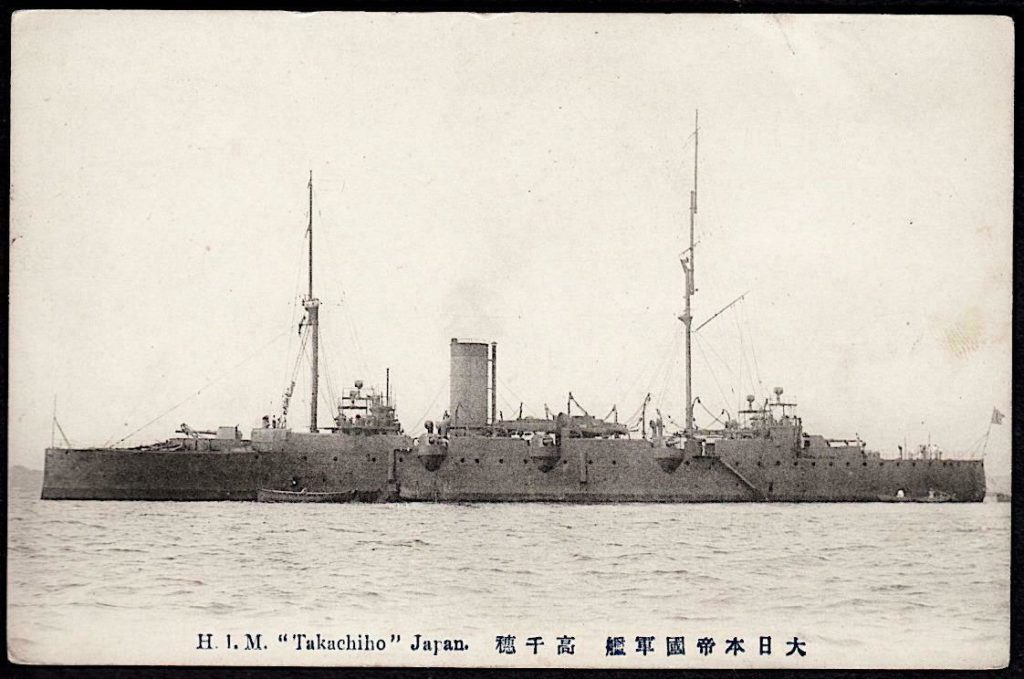
 Latest Facebook Entry -
Latest Facebook Entry -  X(Tweeter) Naval Encyclopedia's deck archive
X(Tweeter) Naval Encyclopedia's deck archive Instagram (@navalencyc)
Instagram (@navalencyc)





 French Navy
French Navy Royal Navy
Royal Navy Russian Navy
Russian Navy Armada Espanola
Armada Espanola Austrian Navy
Austrian Navy K.u.K. Kriegsmarine
K.u.K. Kriegsmarine Dansk Marine
Dansk Marine Nautiko Hellenon
Nautiko Hellenon Koninklije Marine 1870
Koninklije Marine 1870 Marinha do Brasil
Marinha do Brasil Osmanlı Donanması
Osmanlı Donanması Marina Do Peru
Marina Do Peru Marinha do Portugal
Marinha do Portugal Regia Marina 1870
Regia Marina 1870 Nihhon Kaigun 1870
Nihhon Kaigun 1870 Preußische Marine 1870
Preußische Marine 1870 Russkiy Flot 1870
Russkiy Flot 1870 Svenska marinen
Svenska marinen Søværnet
Søværnet Union Navy
Union Navy Confederate Navy
Confederate Navy Armada de Argentina
Armada de Argentina Imperial Chinese Navy
Imperial Chinese Navy Marinha do Portugal
Marinha do Portugal Mexico
Mexico Kaiserliche Marine
Kaiserliche Marine 1898 US Navy
1898 US Navy Sovietskiy Flot
Sovietskiy Flot Royal Canadian Navy
Royal Canadian Navy Royal Australian Navy
Royal Australian Navy RNZN Fleet
RNZN Fleet Chinese Navy 1937
Chinese Navy 1937 Kriegsmarine
Kriegsmarine Chilean Navy
Chilean Navy Danish Navy
Danish Navy Finnish Navy
Finnish Navy Hellenic Navy
Hellenic Navy Polish Navy
Polish Navy Romanian Navy
Romanian Navy Turkish Navy
Turkish Navy Royal Yugoslav Navy
Royal Yugoslav Navy Royal Thai Navy
Royal Thai Navy Minor Navies
Minor Navies Albania
Albania Austria
Austria Belgium
Belgium Columbia
Columbia Costa Rica
Costa Rica Cuba
Cuba Czechoslovakia
Czechoslovakia Dominican Republic
Dominican Republic Haiti
Haiti Hungary
Hungary Honduras
Honduras Estonia
Estonia Iceland
Iceland Eire
Eire Equador
Equador Iran
Iran Iraq
Iraq Latvia
Latvia Liberia
Liberia Lithuania
Lithuania Mandchukuo
Mandchukuo Morocco
Morocco Nicaragua
Nicaragua Persia
Persia San Salvador
San Salvador Sarawak
Sarawak Uruguay
Uruguay Venezuela
Venezuela Zanzibar
Zanzibar Warsaw Pact Navies
Warsaw Pact Navies Bulgaria
Bulgaria Hungary
Hungary

 Bundesmarine
Bundesmarine Dutch Navy
Dutch Navy Hellenic Navy
Hellenic Navy Marina Militare
Marina Militare Yugoslav Navy
Yugoslav Navy Chinese Navy
Chinese Navy Indian Navy
Indian Navy Indonesian Navy
Indonesian Navy JMSDF
JMSDF North Korean Navy
North Korean Navy Pakistani Navy
Pakistani Navy Philippines Navy
Philippines Navy ROKN
ROKN Rep. of Singapore Navy
Rep. of Singapore Navy Taiwanese Navy
Taiwanese Navy IDF Navy
IDF Navy Saudi Navy
Saudi Navy Royal New Zealand Navy
Royal New Zealand Navy Egyptian Navy
Egyptian Navy South African Navy
South African Navy






























 Ukrainian Navy
Ukrainian Navy dbodesign
dbodesign